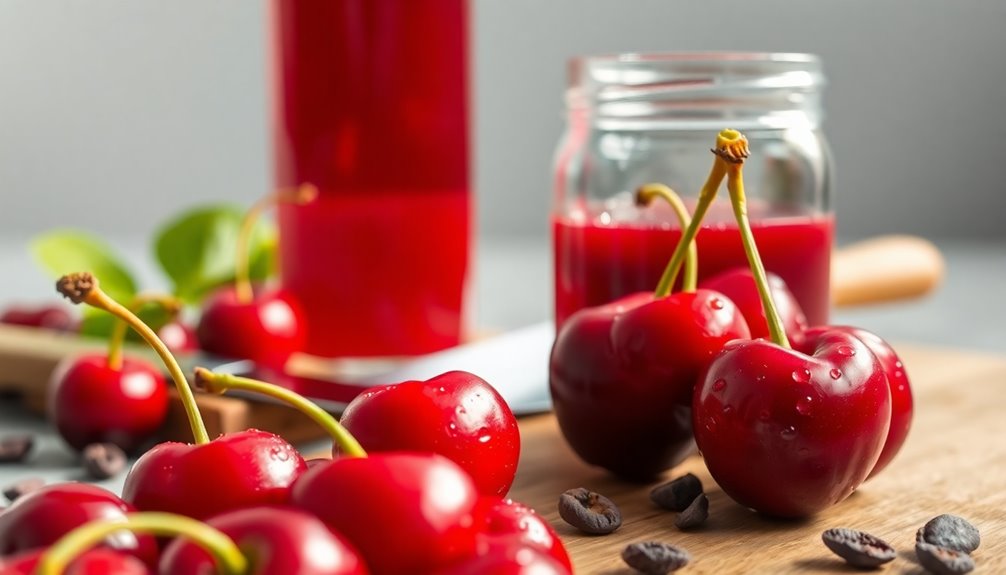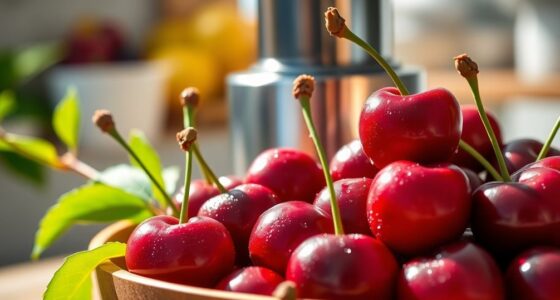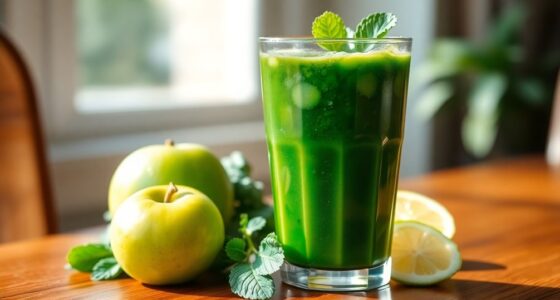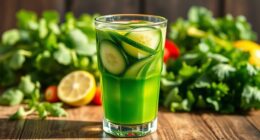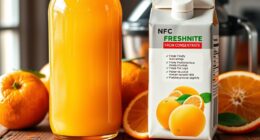To make cherry juice, start with fresh or frozen cherries, washing and pitting them. You can use a juicer or blend the pitted cherries with cold water until smooth. Strain the mixture through a fine mesh strainer to separate the juice from the pulp. For a richer flavor, simmer cherries in water for about 20 minutes before straining. Sweeten to taste, and enjoy your homemade juice. There's plenty more to discover about serving and storing it!
Key Takeaways
- Start by washing and pitting fresh or frozen organic cherries to ensure a clean juice without unpleasant bits.
- Extract juice using a juicer or blend pitted cherries with cold water, then strain to separate juice from pulp.
- For concentrated cherry juice, simmer pitted cherries with water in a saucepan for about 20 minutes before straining.
- Sweeten the juice with sugar, honey, or lemon juice, and consider mixing it with carbonated water for a refreshing drink.
- Store homemade cherry juice in the refrigerator for 1-2 days or freeze it in an airtight container for up to three months.
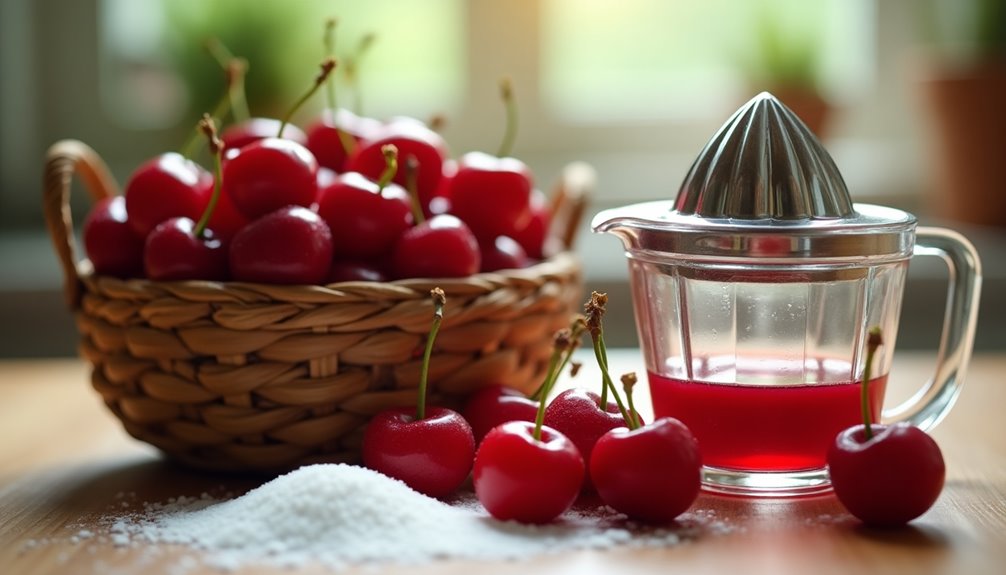
Making cherry juice is a simple and rewarding process, especially when you use fresh or frozen organic cherries. The first step is pitting your cherries, which is crucial whether you're using them fresh or frozen. If you opt for fresh cherries, wash them thoroughly to remove any dirt or residues. Pitting can be a bit time-consuming, but it's worth it to avoid any unpleasant bits in your juice. If you have a cherry pitter, that'll make the job much easier; otherwise, a small knife will work too.
Once your cherries are pitted, you can choose between using a juicer or a blender to extract the juice. If you're using a blender, toss the pitted cherries into it along with a bit of cold water. Start blending until you achieve a smooth consistency. This method not only preserves the flavor but also allows you to enjoy the health benefits of the cherries.
After blending, you'll need to strain the mixture using a fine mesh strainer. This will help you separate the juice from the pulp, giving you a smooth and enjoyable drink.
If you prefer a concentrated version of cherry juice, you can take a slightly different approach. Combine your pitted cherries with water in a saucepan, bringing the mixture to a boil. Once it reaches a boil, reduce the heat and let it simmer for about 20 minutes. This process helps extract even more flavor and nutrients from the cherries.
After simmering, strain the mixture through the fine mesh strainer to separate the juice from any remaining solids. The result is a rich, flavorful juice that can be enjoyed on its own or used in various recipes.
Now that you have your homemade cherry juice, you might want to sweeten it to taste. Depending on your preference, you can add sugar, honey, or even a splash of lemon juice for an extra zing. If you're looking for a refreshing drink, consider mixing your cherry juice with carbonated water for a bubbly twist. This is especially delightful on a hot day when you want something cool and revitalizing.
Once you've prepared your juice, it's important to store it properly. You can refrigerate your homemade cherry juice for 1-2 days, but if you want to keep it longer, freezing is the way to go. Just pour the juice into an airtight container and freeze it. You can enjoy your cherry juice for up to three months while preserving its freshness and flavor.
Making your own cherry juice at home isn't only a fun activity, but it also allows you to control the ingredients and flavors. So gather your cherries, get pitting, and enjoy creating a delicious and refreshing drink that you can savor any time!
Frequently Asked Questions
How Do You Extract Juice From Cherries?
To extract juice from cherries, you'll want to start by washing and pitting them.
Next, use a juicer for the quickest results, feeding the pitted cherries directly into the machine.
If you don't have a juicer, blend the cherries with cold water and strain the mixture through a fine sieve.
Alternatively, you can mash the cherries and press them through a strainer or nut milk bag to get that delicious juice.
How Is Cherry Juice Made?
Cherry juice is made by processing cherries to extract their liquid.
You can start by pitting fresh or frozen cherries and then blending them with water.
Strain the mixture through a fine mesh sieve to get the juice.
Another option is to boil the cherries with water to create a concentrate.
For a simpler method, mash the cherries and press them through a nut milk bag.
Enjoy your fresh juice right away or store it for later!
Can You Drink Cherry Juice Everyday?
Drinking cherry juice every day can be like having a little health booster in your routine.
It's packed with antioxidants that can help reduce inflammation and aid post-exercise recovery.
If you're keen on heart health, its potassium content might lower your blood pressure.
Aim for 8 to 12 ounces daily, but listen to your body and adjust as needed.
Just make sure it's 100% pure juice to get the best benefits without unwanted extras.
Can You Juice Cherries With the Pits?
Yes, you can juice cherries with the pits, especially using methods like steam juicing.
This technique lets you process whole cherries without removing the pits, making it convenient for larger quantities.
Just keep in mind that leaving the pits in may add a slight bitterness to the juice due to certain compounds. To mitigate this bitterness while still enjoying the health benefits, you can carefully remove the pits before processing the fruit. When learning how to prepare bitter gourd juice, consider combining it with sweeter fruits like apples or pears to balance the flavors. Additionally, adding a dash of lemon or ginger can enhance the taste, making the juice more palatable while still retaining its nutritional value.
If you're using a blender, though, it's best to pit the cherries first to prevent damaging your equipment.
Conclusion
Now that you know how to make delicious cherry juice, you can enjoy its vibrant flavor and health benefits. Did you know that just one cup of cherry juice contains more antioxidants than a serving of blueberries? By making your own juice, you not only control the ingredients but also tap into the natural goodness packed in those cherries. So grab some fresh cherries and start juicing for a refreshing drink that's both tasty and nutritious!
Cindy thoroughly researches juicing trends, techniques, and recipes to provide readers with practical advice and inspiration. Her writing style is accessible, engaging, and designed to make complex concepts easy to understand. Cindy’s dedication to promoting the advantages of juicing shines through her work, empowering readers to make positive changes in their lives through the simple act of juicing.

